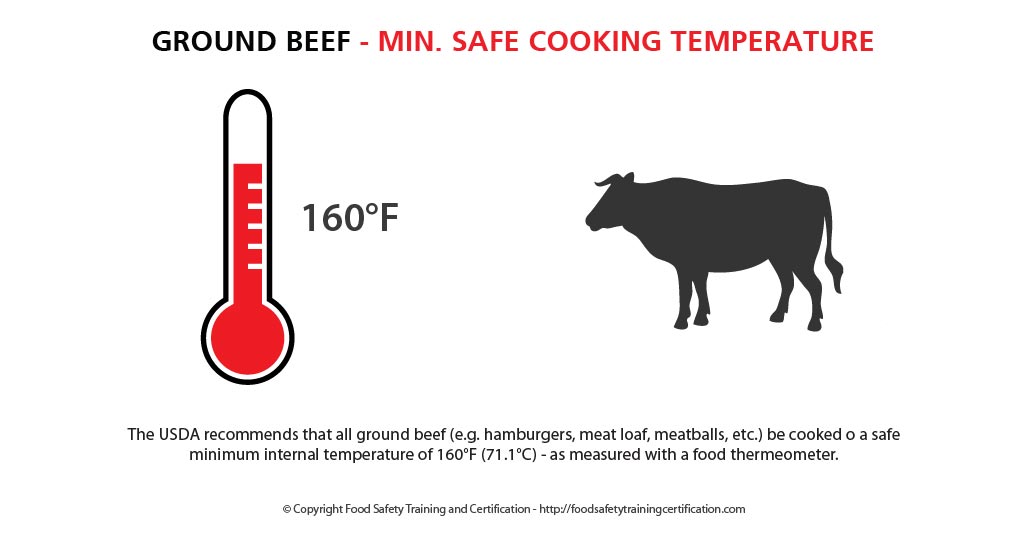Eating undercooked beef can put you at risk for foodborne illness. That’s why it’s critical to cook beef to a safe internal temperature that kills harmful bacteria like E. coli and Salmonella. So what temperature should you cook your beef to? This comprehensive guide will teach you the safe internal temperatures for various cuts of beef, plus tips for proper storage, thawing, and reheating.
Why Internal Temperature Matters
The only way to ensure beef has been cooked to a temperature that kills bacteria is to measure the internal temperature with a meat thermometer. You can’t rely on color or texture alone. Use the following temperature guidelines for safe beef cooking:
-
Ground Beef: Cook to 160°F (71°C) minimum since harmful germs can contaminate the meat during processing.
-
Steaks, Chops Roasts Cook to at least 145°F (63°C) with a 3 minute rest time. This temperature destroys illness-causing bacteria while keeping the beef juicy.
-
Rare Beef (120-130°F): Not recommended for food safety reasons, especially for the elderly, young children, pregnant women, and those with weakened immune systems.
Danger Zone: 40-140°F
Harmful bacteria multiply rapidly between 40-140°F (4-60°C). Never leave beef sitting out for over 2 hours at room temperature (1 hour if above 90°F).
Measuring Internal Temperature
-
Use an instant-read thermometer for steaks, inserted horizontally into the thickest part away from bone or fat.
-
For roasts, use an oven-safe thermometer left in during cooking or an instant-read thermometer after. Insert into the thickest part.
-
Allow a 5-10°F carryover cooking after removing beef from the heat source. The temperature will continue rising as it rests.
Safe Internal Temperatures for Various Beef Cuts
-
Steaks:
- Rare – 120-125°F (49-52°C)
- Medium Rare – 130-135°F (54-57°C)
- Medium – 140-145°F (60-63°C)
- Medium Well – 145-150°F (63-66°C)
- Well Done – 150°F+ (65°C+)
-
Ground Beef: 160°F (71°C) minimum
-
Roasts 145°F (63°C) for medium rare. 160°F (71°C) for medium. 170°F (76°C) for well done
Resting, Storage and Reheating Tips
-
Resting: Allow steaks and roasts to rest 5-10 minutes after cooking to lock in juices.
-
Refrigerating: Store cooked beef in airtight containers within 2 hours of cooking (1 hour if over 90°F). Steaks/roasts last 3-5 days, ground beef just 1-2 days.
-
Freezing: Wrap tightly in freezer bags, plastic wrap, or foil to prevent freezer burn. Steaks/roasts last 6-12 months, ground beef 3-4 months.
-
Thawing: Thaw frozen beef slowly in the fridge, never at room temperature.
-
Reheating: Use the oven or skillet for steaks/roasts, microwave or skillet for ground beef. Reheat fully cooked ham to 140°F.
Key Takeaways
-
Always use a meat thermometer to verify safe internal temperatures. Color is not a reliable indicator of doneness.
-
Cook ground beef to 160°F minimum since the grinding process can introduce bacteria throughout the meat.
-
Allow 5-10°F carryover cooking after removing beef from the heat source. The temperature will continue rising as it rests.
-
Chill cooked beef within 2 hours of cooking. Store steaks/roasts for 3-5 days, ground beef for just 1-2 days.
-
Frozen beef lasts 6-12 months for steaks/roasts, 3-4 months for ground beef when properly wrapped to prevent freezer burn.
Cooking your beef accurately to a safe internal temperature is crucial for avoiding foodborne illness. Use a reliable meat thermometer and follow these guidelines to ensure your beef reaches the right temp for safety and deliciousness.

Medium Steak: 140° to 145°
If you don’t like to bite into red but still want to savor a tender steak, then you need to cook your steak medium. Inside, the meat is pink and warm, with lighter pink edges. To cook a medium steak, take it off the heat at 135° and let it rest while you finish setting the table. This will ensure your steak is the right level of doneness for your preference without being overcooked or dry.
Well-Done Steak: 160° to 165°
A well-done steak spends the maximum amount of time on the heat, resulting in a center with no pink. If you want to cook your steak to this level of doneness, make sure to stop cooking it when the temperature hits 155°. You don’t want to overcook the meat, or else it can become chewy and dry. Instead, let it finish cooking off the heat for a few minutes while you finish getting dinner on the table. You’ll be amazed how a little patience really pays off and creates the juiciest possible steak.
Cooking 101: Proper cooking Temperatures to Ensure Safe Food – White Apron Catering, Lake Worth, Fl
FAQ
Is beef safe to eat at 135?
Note: There are three important temperatures to remember when cooking meat or eggs at home: Eggs and all ground meats must be cooked to 160°F; poultry and fowl to 165°F; and fresh meat steaks, chops and roasts to 145°F.
Is it safe to eat beef at 130 degrees?
To safely eat a steak, grill or sear it on high heat. Then bring the internal temperature up to 120-125°F (rare), 125-130°F (medium rare), or 135-140°F. To safely eat ground beef, an internal temperature of 160°F must be reached.Sep 23, 2022
What is the safest temperature for beef?
| Product | Minimum Internal Temperature and Rest Time |
|---|---|
| Beef, Pork, Veal and Lamb Steaks, Chops and Roasts | 145 degrees F (62.8 degrees C) and allow to rest for at least 3 minutes |
| Ground Meats | 160 degrees F (71.1 degrees C) |
| Ground Poultry | 165 degrees F |
Can you eat beef at 150?
For beef, lamb, and veal, the USDA recommends an internal temperature of 145°F (63°C). I prefer rare at 125 to 130°F (52–55°C). If you prefer medium rare, cook to 130 to 140°F (55–60°C). For medium well, 150 to 160°F (66–71°C).
